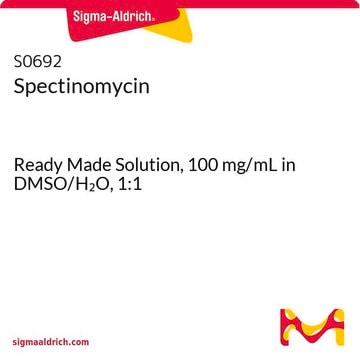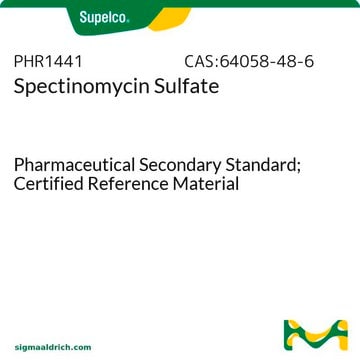Kluczowe dokumenty
S2647
Spectinomycin dihydrochloride pentahydrate
powder, γ-irradiated
About This Item
Polecane produkty
pochodzenie biologiczne
synthetic (inorganic)
Poziom jakości
klasa czystości
Molecular Biology
sterylność
γ-irradiated
Formularz
powder
siła działania
≥500 μg per mg
warunki przechowywania
(Keep container tightly closed in a dry and well-ventilated place. Keep in a dry place.)
kolor
white to off-white
rozpuszczalność
H2O: soluble at
spektrum działania antybiotyku
Gram-negative bacteria
Gram-positive bacteria
Tryb działania
protein synthesis | interferes
temp. przechowywania
2-8°C
przydatność
nonselective for Escherichia coli
nonselective for coliforms
ciąg SMILES
O.O.O.O.O.Cl.Cl.CN[C@@H]1[C@H](O)[C@H](NC)[C@H]2O[C@]3(O)[C@@H](O[C@H](C)CC3=O)O[C@@H]2[C@H]1O
InChI
1S/C14H24N2O7.2ClH.5H2O/c1-5-4-6(17)14(20)13(21-5)22-12-10(19)7(15-2)9(18)8(16-3)11(12)23-14;;;;;;;/h5,7-13,15-16,18-20H,4H2,1-3H3;2*1H;5*1H2/t5-,7-,8+,9+,10+,11-,12-,13+,14+;;;;;;;/m1......./s1
Klucz InChI
DCHJOVNPPSBWHK-UXXUFHFZSA-N
Szukasz podobnych produktów? Odwiedź Przewodnik dotyczący porównywania produktów
Opis ogólny
Zastosowanie
Działania biochem./fizjol.
Mode of Resistance: A mutation in rpsE, the gene for ribosomal protein S5, prevents the binding of spectinomycin. Resistance is also conferred by the aminoglycoside-3′-adenyltransferase gene (aadA).
Antimicrobial spectrum: Spectinomycin acts against gram-negative and gram-positive bacteria.
Opakowanie
Przestroga
Uwaga dotycząca przygotowania
Inne uwagi
produkt powiązany
Hasło ostrzegawcze
Warning
Zwroty wskazujące rodzaj zagrożenia
Zwroty wskazujące środki ostrożności
Klasyfikacja zagrożeń
Eye Irrit. 2 - Skin Irrit. 2 - STOT SE 3
Organy docelowe
Respiratory system
Kod klasy składowania
11 - Combustible Solids
Klasa zagrożenia wodnego (WGK)
WGK 2
Temperatura zapłonu (°F)
Not applicable
Temperatura zapłonu (°C)
Not applicable
Środki ochrony indywidualnej
Eyeshields, Gloves, type N95 (US)
Wybierz jedną z najnowszych wersji:
Masz już ten produkt?
Dokumenty związane z niedawno zakupionymi produktami zostały zamieszczone w Bibliotece dokumentów.
Klienci oglądali również te produkty
Nasz zespół naukowców ma doświadczenie we wszystkich obszarach badań, w tym w naukach przyrodniczych, materiałoznawstwie, syntezie chemicznej, chromatografii, analityce i wielu innych dziedzinach.
Skontaktuj się z zespołem ds. pomocy technicznej









